1960s
A silly millimeter longer
In 1966, Benson & Hedges introduced the "100" — an extralong, 100-millimeter cigarette. Their tongue-in-cheek commercials focused on the supposed disadvantages of such a long cigarette.Not to be outdone, the makers of Chesterfields responded by introducing the "101", which was 101 millimeters long. As they put it, it was a "silly millimeter longer."
As far as I know, no one ever introduced a "102" cigarette.
Posted By: Alex - Fri Sep 04, 2020 -
Comments (5)
Category: Smoking and Tobacco, 1960s
Why aren’t your feet as sexy as the rest of you?
One of life's great mysteries.The ad ran in Cosmopolitan magazine (and probably other publications) in the late 1960s.
I found it in The Sex Life of the Foot and Shoe (1976) by William A. Rossi.
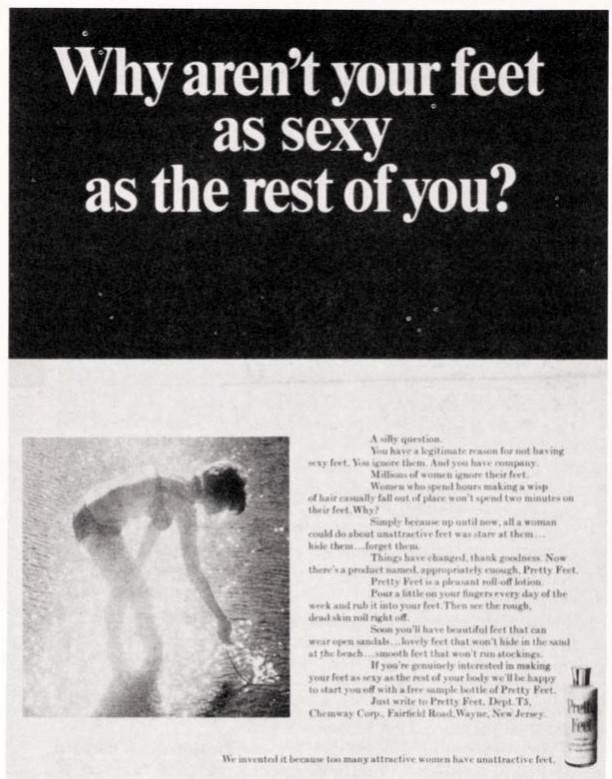
Posted By: Alex - Wed Sep 02, 2020 -
Comments (4)
Category: Advertising, 1960s, Feet
North to Alaska
Here's a type of song, a story ballad, that seems pretty much extinct these days. (Any WU-vie who can cite a contemporary instance gets a No-Prize!) It seems, judging by the film clips in this video, to recount the entire arc of the movie!The Wikipedia page for the film.
Posted By: Paul - Fri Aug 28, 2020 -
Comments (4)
Category: History, Movies, Music, Regionalism, 1960s
1969 Design Proposals for NYC
A 200-MPH transit system, a dome over Times Square, and other daydreams.Source.
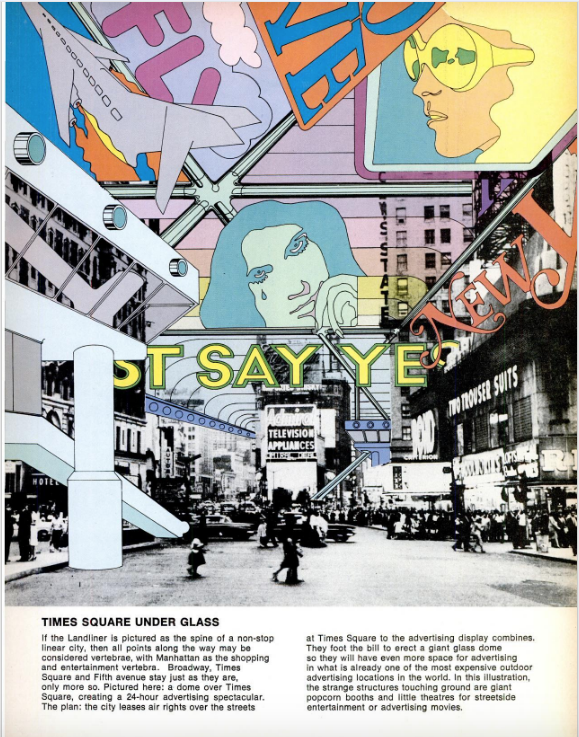
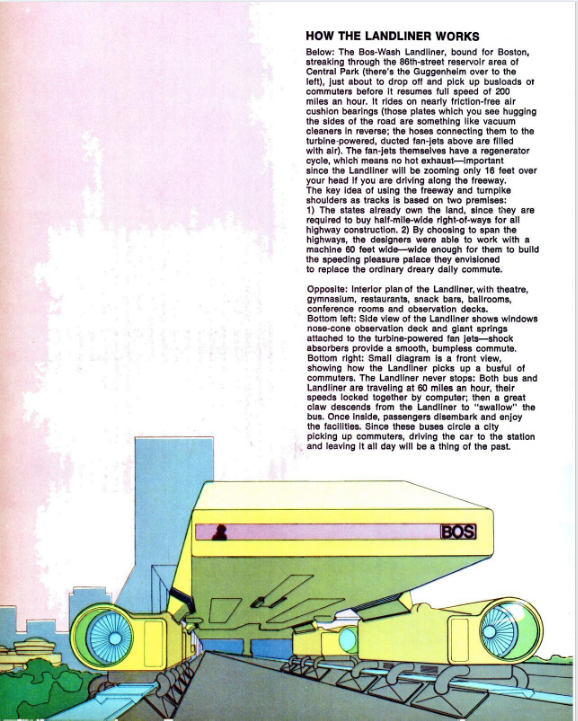
Posted By: Paul - Wed Aug 26, 2020 -
Comments (3)
Category: Motor Vehicles, Urban Life, 1960s, Yesterday’s Tomorrows
UK’s Central Government War HQ
The Central Government War Headquarters (CGWHQ) is a 35-acre (14 ha)[1] complex built 120 feet (37 m) underground[2] as the United Kingdom's emergency government war headquarters – the hub of the country's alternative seat of power outside London during a nuclear war or conflict with the Soviet Union. It is located in Corsham, Wiltshire, in a former Bath stone quarry known as Spring Quarry, under the present-day MoD Corsham.[3]
The Wikipedia page.
Posted By: Paul - Tue Aug 25, 2020 -
Comments (3)
Category: War, 1960s, United Kingdom
Cherry Berry Wine
Biblical revisionism regarding the influence of alcohol on historical events.
Posted By: Paul - Mon Aug 24, 2020 -
Comments (0)
Category: Music, Religion, 1960s, Alcohol
The Holie Terra
Seeking a way to use technology to win the tunnel warfare in Vietnam, Nelson Frost of Byram, Connecticut invented the "Holie Terra." Although in the write-up for the patent he received (No. 3,395,641), he referred to it more formally as a "remotely controlled tunnel exploration and destroying means."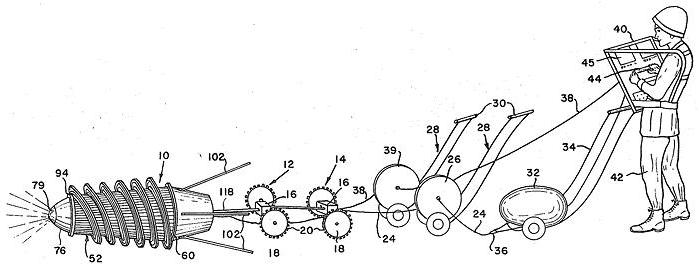
From his patent:
More particularly, it is an object of the invention to provide a tunnel exploring device which may be maneuvered from a remote position deep into the tunnel network and there be detonated so that there is a much higher kill probability of the enemy forces with greater safety to the attackers than has been possible by any means employed heretofore.

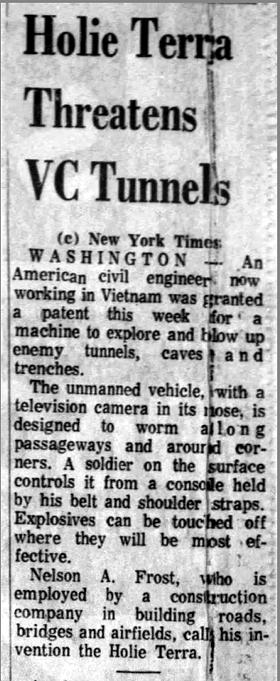
Montgomery Advertiser - Aug 15, 1968
Posted By: Alex - Sun Aug 23, 2020 -
Comments (2)
Category: War, Weapons, Patents, 1960s
Hitler’s Toilet Seat
December 1969: ex-RAF pilot Guy Harris put a toilet seat up for auction that he claimed to have removed from Hitler's bunker in Berlin. He said he had found it in the private apartment used by Hitler and Eva Braun.According to Harris, he and other British soldiers had been allowed in the bunker by the Russians, who had already removed everything they believed to be of value. But they evidently hadn't thought Hitler's toilet seat was of any value. So Harris took it.
When he got back to England, he first installed it in his 90-foot yacht on the Thames. Later he moved it to his home in Twickenham, before finally deciding to sell it.
There's no record, however, of whether he did manage sell it. At least, none that I can find.

Albany Democrat Herald - Dec 18, 1969

Los Angeles Times - Dec 17, 1969
As it turns out, Harris wasn't the only soldier to have nabbed a Hitler toilet seat. There are two more floating around out there. One was taken from Hitler's mountain retreat, the Berghof. The other from Hitler's private yacht, the Aviso Grille. This latter one is currently located in an auto repair shop in New Jeresy. More info: Anchorage News
Posted By: Alex - Sun Aug 16, 2020 -
Comments (1)
Category: Bathrooms, Dictators, Tyrants and Other Harsh Rulers, 1960s
Sounds of War
On the heels of yesterday's post, and thanks to loyal and creative WU-vie KDP, comes this literal blast from his past. We hope it brings back childhood memories.
Posted By: Paul - Wed Aug 12, 2020 -
Comments (1)
Category: War, Reader Recommendation, Special Effects, 1960s
Mother Heart
Japan's "crazy inventor" Hiroshi Majima invented this odd device:The tot apparently feels secure and reassured, stops yelling and drifts off to sleep without another whimper.
Bed-wetting is also greatly reduced, inventor Majima finds.
"Mother Heart" now sells abroad, not just on Japan's domestic market alone. Ready-made markets, Majima says, have been found in the Mediterranean countries, like France, Italy, and Spain, where mothers are especially close to their infants, and vice versa.


Allentown Morning Call - Sep 16, 1965
We previously featured another one of Majima's strange inventions on WU: the Cat Mew Machine.
Posted By: Alex - Wed Jul 29, 2020 -
Comments (0)
Category: Babies, Inventions, 1960s

| Who We Are |
|---|
| Alex Boese Alex is the creator and curator of the Museum of Hoaxes. He's also the author of various weird, non-fiction, science-themed books such as Elephants on Acid and Psychedelic Apes. Paul Di Filippo Paul has been paid to put weird ideas into fictional form for over thirty years, in his career as a noted science fiction writer. He has recently begun blogging on many curious topics with three fellow writers at The Inferior 4+1. Contact Us |




